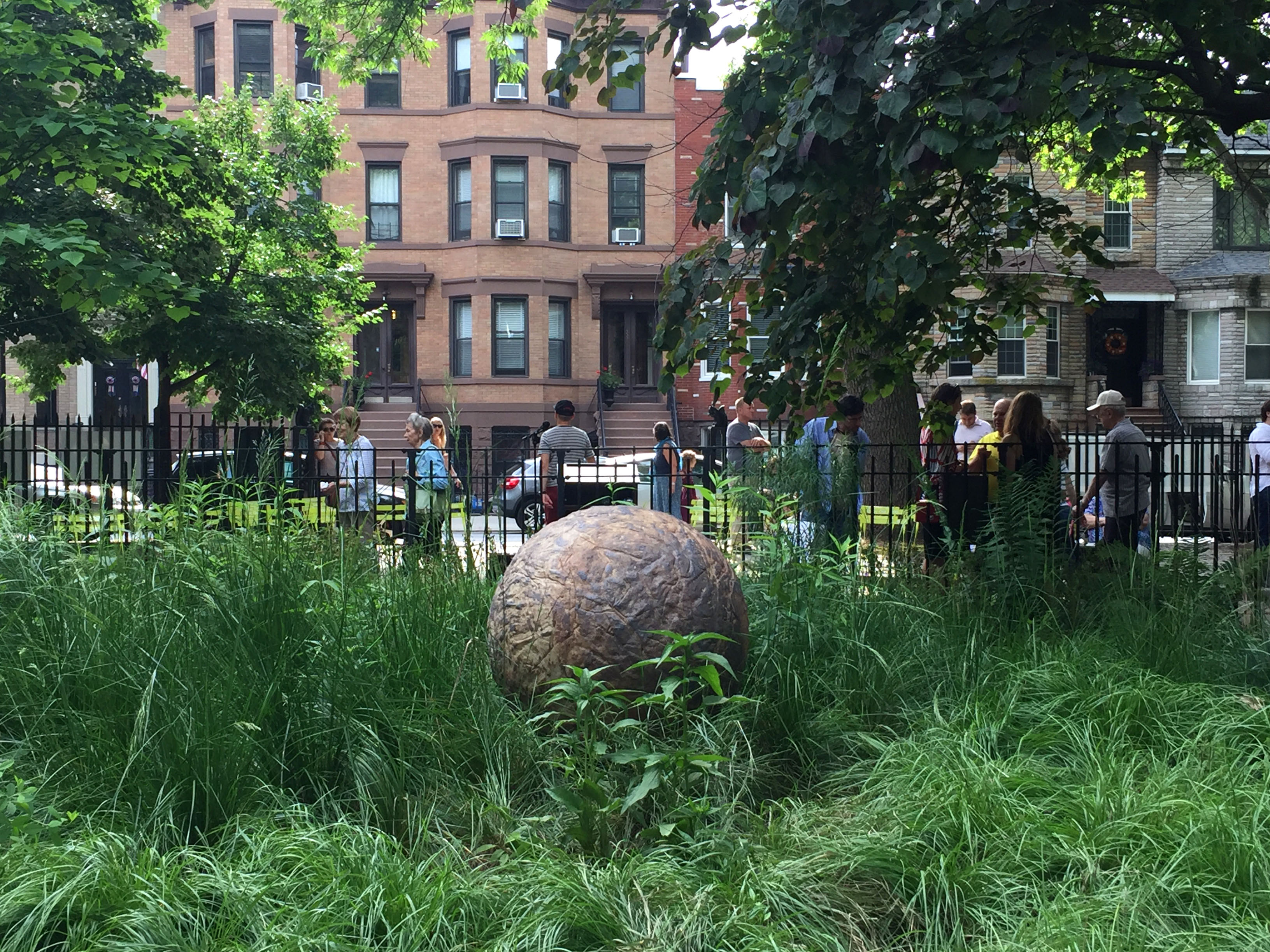One past public artwork:
One monument:
NYC AIDS Memorial Park at St. Vincent’s Triangle


- Location: 12th Street and Greenwich Avenue
- Sculptor: Jenny Holzer (inscribed granite paving)
- Architect: Studio ai
- Description: Abstract canopy with engraved paving and fountain
- Materials: structural steel, granite, stainless steel
- Dedicated: December 1, 2016
“The memorial is a built as a place of contemplation and provides a shelter for reflection and remembrance of the men, women, and children lost to AIDS. It also serves as a gathering place and reminder of the work that remains to defeat the disease.”
I think it is very effective as it’s a perfect shelter where people can stay and remember those who are lost fighting AIDs. Here people can mourn for the loss of a family member or a dear friend. This place provides comfort and empathy through people who have gone through a similar experience. The text engraved on the monument, which is a poem written by poet Walt Whitman ” Song of Myself”, celebrates hope, unity, and human dignity is another comfort place where people can reflect and relieve themselves.
The only question I have to the design is the harsh geometric structure of the monument, because, to me, a place where people can receive comfort should be somewhere warm and cozy, and yet this place gives off a cold and concrete feeling which is completely opposite from comfort and relieve.
As New York is a very big and diverse city, full of things happening every day, not just in a good way, but also diseases and death. Therefore, I think NYC is the best place to place this monument, because of how influential the city is and everything that’s happening here.
one memorial located in New York City:
Berlin Wall Artifacts (5 spots in NYC)
:no_upscale()/cdn.vox-cdn.com/uploads/chorus_image/image/59852493/W1siZiIsInVwbG9hZHMvcGxhY2VfaW1hZ2VzLzBjNDMwNTA3N2FhOWM4YzA2Yl80Mjc2NzEzOTIwXzNjMDk1M2FmNzNfei5qcGciXSxbInAiLCJ0aHVtYiIsIjk4MHhcdTAwM2UiXSxbInAiLCJjb252ZXJ0IiwiLXF1YWxpdHkgOTEgLWF1dG8tb3JpZW50Il1d.0.0.0.0.jpeg)

- Location:
- 520 Madison Ave
- Kowsky Plaza
- United Nation
- Ripley’s Believe it or not
- Intrepid Museum
- Materials: grafitti
- Dedicated:
- 520 Madison Ave: 1990
- Kowsky Plaza: 2004
- United Nation: 2002
- Ripley’s Believe it or not: (not recorded)( I cannot find it)
- Intrepid Museum: (not recorded)( I cannot find it)
“In the early 1980s, artist Thierry Noir began painting the surfaces on the west side of the Berlin Wall, close to his apartment. In an effort to make the wall seem less menacing, other artists joined in, covering various sections of the wall with painted figures and graffiti. The 14-foot tall wall became a huge canvas, giving voice to artists from around the world, and a popular tourist destination.
The dismantling of the Wall was completed in 1991, with more than 40,000 wall sections recycled into building materials used for German reconstruction projects. However, a few hundred sections were preserved, sold, auctioned off or given away. Five of these sections are here in New York City. ”
I went to Berlin this summer and saw the magnificent Berlin Wall during my stay, which is one of the reasons why I chose to learn more about this memorial. I was surprised to learn that there are five spots in NYC that also preserve segments of the Wall. It is a reminder of segregation that should have not existed. Personally to me, it relates to the city very well. NYC is such a diverse place, while it’s known for its diversity, the segregation is still visible, immigrants and nonimmigrants, race as well as local and non-local people. Therefore, the significance of these fragments of the Wall takes on the role of reminding me, and the people who are in this bustling city that segregation is something we should learn to reduce and go against.
Temporary Public Artwork:

Ziemia
- Location: McGolrick Park, Brooklyn
- Sculptor: Martynka Wawrzyniak i
- Materials: The ceramic orb is glazed with a mixture of clay excavated in Greenpoint as well as soils contributed by participating residents from places that are symbolically representative of their identities
- Ongoing: June 9, 2018 to June 8, 2019
“The sculpture serves as a collective portrait of the community. It is also a cultural locus focused on the social and ecological history of the neighborhood.
The meadow is composed of species which date to the pre-colonial times. Meaningfully, the same species can be found in the Polish countryside. Soils from foreign countries which were used in the ceramic glaze were imported with an official USDA Soil Importing Permit and Heat Treated at Lehman College of CUNY. ”
As mentioned in the quote, the sculpture serves as a collective portrait of the community. It represents diversity and harmony, which is what New York is all about. Therefore I think placing this sculpture in NY is more than appropriate.